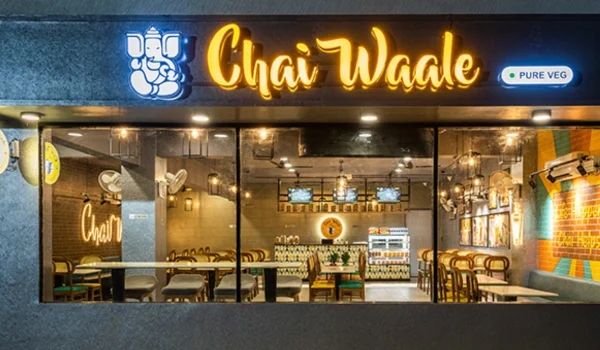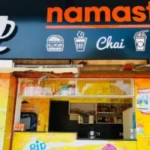Chai Waale positions itself as a modern, global-style quick-service tea & snack restaurant that blends traditional Indian chai with fast-food offerings like sandwiches, wraps, and local snacks. They operate across urban centers, student hubs, malls, and are expanding steadily—aiming to recreate the tea ritual for today’s consumer.
💰 Investment & Cost Overview
📊 Cost Breakdown Table
| Component | Estimate (₹ lakh) |
| Space Required | 300–500 sq.ft |
| Franchise Fee | ₹5–8 L |
| Setup & Interiors | ₹7–12 L |
| Equipment & Inventory | ₹3–5 L |
| Total Investment Range | ₹10–20 L |
| Royalty/Commission | ~5–6% of net sales |
| Agreement Term | 5 years (typically renewable) |
| Expected ROI | 60–120% over 5 years |
| Typical Break-even | 12–24 months |
- Based on FranchiseIndia, the investment range for Chai Waale sits around ₹10–20 lakh for a 300–500 sq.ft outlet, with ~6% royalty and contract tenure of 5 years.
- Comparable brands in the chai‑café space follow a similar structure, where setup and franchise fees form the bulk of initial capex.
🏗 Franchise Model & Brand Support

🌐 Business Format
- FOFO (Franchise-Owned, Franchise-Operated) model: you manage daily operations, while the brand provides SOPs, supply chain, training, and support ([turn0search6]).
- Outlet size: 300–500 sq.ft, designed for high footfall zones such as campuses, corporate parks, or mall corridors.
🛠️ Support & Training
Chai Waale typically offers:
- Location assessment assistance: footfall and demographic evaluation.
- Interior and décor templates aligned with brand identity.
- Comprehensive training in operations, hygiene, staffing, and product consistency.
- Supply chain interface to ensure consistent ingredients and snacks.
- Promotion support using brand-level and local marketing efforts.
- Ongoing operational guidance and field audits.
📈 Revenue Potential & ROI
🎯 Sales & Margins
- Typical Sales: ₹3–4 lakh per month for small outlets; ₹5–6 lakh or more in top locations.
- Gross Margins: Food & beverage cost ~40–45%, leaving ~55–60% gross profit.
- Applying royalties (5–6%), staffing, rent, utilities, and miscellaneous—net margins can fall between 15–25% initially, potentially rising to 30–35% with scale.
🔁 ROI Estimates
- Conservative payback period: 12–18 months for high-traffic outlets.
- Average outlets: 18–24 months for break-even.
- Over five years, cumulative ROI of ~60–120% is plausible depending on location and growth.
✅ Eligibility & Ideal Franchisee Profile
You should ideally meet the following criteria:
- Capital readiness: ₹10–20 lakh including working capital buffer.
- Location access: Own or lease 300–500 sq.ft in high traffic areas.
- Operational capability: Comfortable managing 5–10 staff, inventory, and service.
- Background: F&B or retail experience helps but isn’t mandatory; strong commitment and SOP discipline essential.
- Legal readiness: PAN, Aadhaar, GST registration, shop lease/license, FSSAI if snacks are served.
- Franchise orientation: Willing to operate under brand systems and support structure.
📝 Step-by-Step: How to Apply
- Initial Enquiry
Submit franchise application via Chai Waale’s official website or franchise listing portals. - Evaluation & Screening
Franchise team reviews capital readiness, site details, background, and motivation. - Site Visit & Validation
Brand representatives assess proposed outlet location for footfall, visibility, and rent dynamics. - Agreement & Payment
Review the franchise agreement (minimum 5-year term); pay franchise fee (~₹5–8 L) and sign contract. - Fit-out & Setup
Complete interior work, branding, equipment installation, signages, and POS systems. - Training & Onboarding
Attend operations training; train staff on menu, service, hygiene standards. - Soft Launch
Brand supports local marketing and formal launch promotions. - Ongoing Support
Operate outlet, receive periodic audits, stock replenishment, and marketing push.
⚖️ Pros & Cons for Prospective Franchisees
✅ Advantages
- Entry cost is moderate (₹10–20 L) compared to larger QSR models.
- Strong brand systems, including training, supply chain, and marketing.
- Diverse menu profiles with chai, iced teas, fusion fast snacks appeal to young audience.
- Potential for high margins (15–35%) with disciplined cost control.
- Scalable footprint, especially in colleges and transit hubs.
❌ Considerations
- F&B industry volatility: high failure rate for cafés if margins slip or footfall drops—frequent advice from former franchisees suggests strong startups risk too ([turn0reddit14]).
- Royalties apply even during low sales months—net margins can shrink in lean periods.
- Location is critical: even a strong brand may struggle in poorly performing zones.
- Contract rigidity: exit/transfer clauses need scrutiny.
- Brand dilution: many similar “chai” outlets occupy the market, requiring differentiation via service and quality.
💡 Expert Tips Before Investing
- Visit multiple existing Chai Waale outlets to gauge service, pricing, and customer flow.
- Speak to current franchisees about real-world support, ROI, and challenges.
- Examine the royalty structure and exit clauses very carefully before signing.
- Negotiate lease/rent escalation caps—real estate overhead affects margins significantly.
- Maintain at least 6 months backup capital for sustaining initial months.
- Plan staffing strategy: frontline consistency and low attrition are vital.
🧾 Franchisee Quick Checklist
- Investment: ₹10–20 lakh (including franchise fee, setup, inventory)
- Space: 300–500 sq.ft
- Staff: 5–10 employees initially
- Franchise Fee: ₹5–8 lakh
- Royalty: ~5–6% of net sales
- Break-even: 12–24 months typical
- Net Profit Margin: ~15–35%
- Agreement: 5-year term, renewable
- Licences: PAN, GST, FSSAI, shop license
🎯 Final Verdict
Chai Waale offers an attractive mid-investment opportunity in India’s expanding quick‑commerce tea and snacks space. With moderate entry costs, structured support, and a modern menu mix, it’s well-positioned to succeed with disciplined operators in high-traffic areas.

Shashi Kant is the Founder and Editor of BusinessScroller.com, a leading platform for business insights, finance trends, and industry analysis. With a passion for journalism and expertise in business reporting, he curates well-researched content on market strategies, startups, and corporate success stories. His vision is to provide valuable information that empowers entrepreneurs and professionals. Under his leadership, BusinessScroller.com has grown into a trusted source for in-depth articles, customer care guides, and financial expertise.


